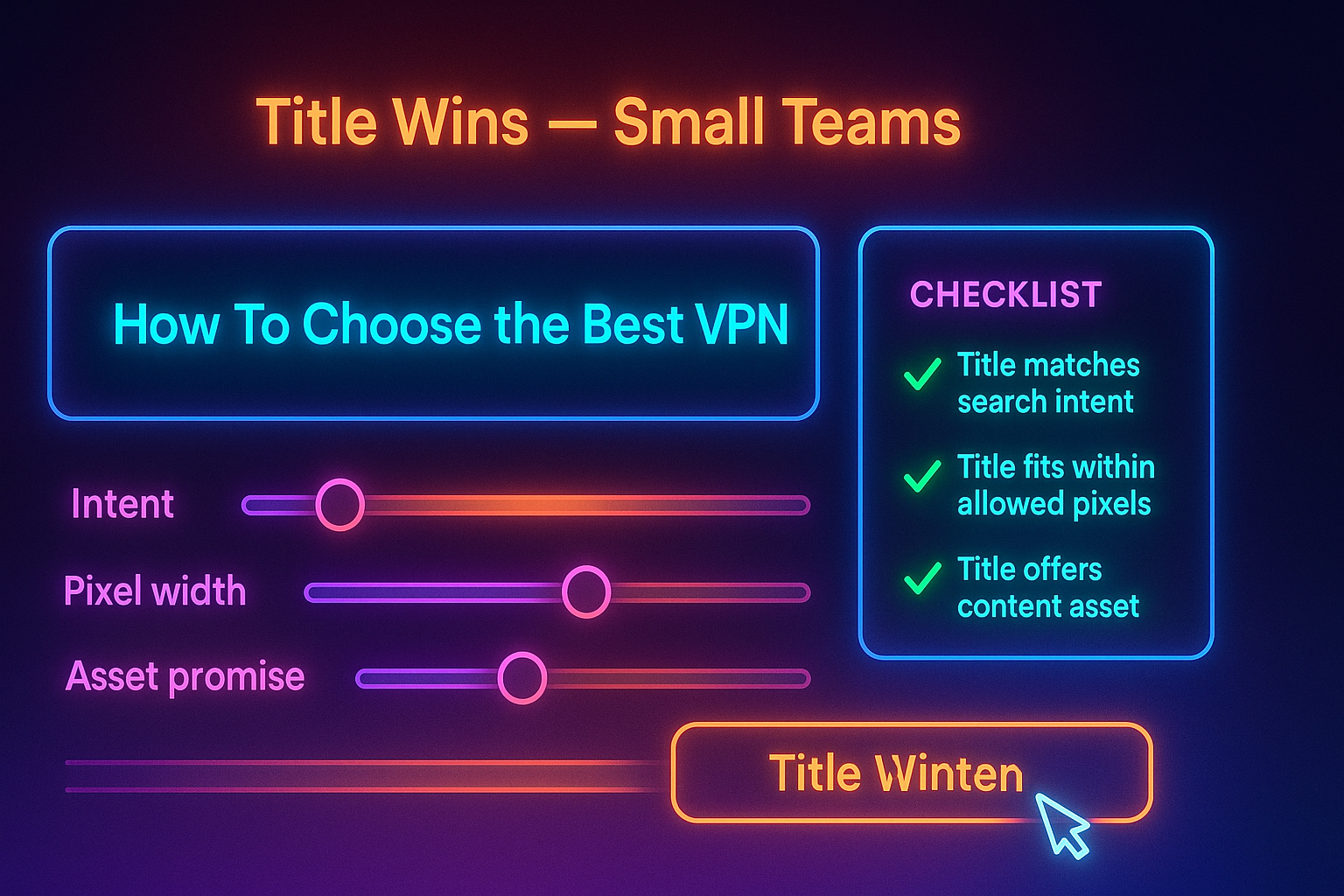A lean 2025 playbook for small teams to ship high-impact title tags fast—map intent, front-load value, prevent truncation, and standardize with safe programmatic rules. Templates, QA, and tool links included.
Cost-effective title tags wins for small teams (2025)
Titles still move CTR in 2025—especially when you sell a specific outcome in the first 55–60 characters. This guide shows small teams how to ship reliable title upgrades in minutes, standardize patterns, and avoid rework using SEO Horizan tools.
The 5 rules that deliver outsized gains
- Intent first: Name the user’s job (how-to, template, pricing, comparison).
- Non-SERP value: Tease what search summaries can’t give (download, calculator, checklist).
- Front-load keywords: Task and object lead; brand at tail.
- Truncation-safe: Optimize for pixels, not characters—verify visually.
- Parity: Title ↔ H1 ↔ description ↔ on-page snippet paragraph (40–55 words).
10–20 minute workflow (repeat weekly)
- Pick 10 URLs: Top traffic + top potential (thin titles, misaligned intent).
- Preview & fit: Open each in Google Search Preview and adjust to avoid mid-word truncation.
- Parity check: Validate title/description/OG with Meta Tags Checker and OpenGraph Checker.
- On-page alignment: Confirm H1 + snippet paragraph exist via Website Text Extractor.
- Link hygiene: Ensure intro links hit final 200s (URL Redirect Checker) and sane headers (HTTP Headers Lookup).
Title patterns (copy, then tailor)
- Problem → Outcome: [Problem]: [Outcome] (2025 guide)
- Asset promise: [Topic] Template + Example (2025)
- Comparison: [X] vs [Y]: key differences & pricing
- Pricing: [Product] pricing: plans, limits & calculator (2025)
- Benchmarks: [Metric] benchmarks for [Audience] (2025 report)
Programmatic titles (safe automation for small teams)
IF type = "template"
title = "{{topic}} Template + Example (2025) — {{brand_short}}"
ELSE IF type = "comparison"
title = "{{x}} vs {{y}}: key differences & pricing — {{brand_short}}"
ELSE IF type = "pricing"
title = "{{product}} pricing: plans & limits (2025) — {{brand_short}}"
ELSE
title = "{{task}}: {{outcome}} (2025) — {{brand_short}}"
Guardrails: 60–65 char soft cap; normalize case; dedupe tokens; collapse repeated nouns; keep brand at tail for non-brand queries.
Snippet paragraph (drop under H1)
<p class="snippet">[40–55 words that say: who this is for, the outcome users get, and the assets included—template, table, calculator. Use plain language.]</p>
Examples (before → after)
Before: Internal linking tips — Brand
After: Internal links quick wins: checklist + examples (2025) — Brand
Before: Pricing — Brand
After: [Product] pricing: plans, limits & calculator (2025) — Brand
Before: [X] vs [Y] — which is better?
After: [X] vs [Y]: key differences, pricing & use cases — Brand
Prioritization (do now → do next)
Item, Impact, Effort, Priority
Rewrite top 20 titles with intent + asset promise, High, Low, Do Now
Add/align snippet paragraphs on those pages, High, Low, Do Now
Standardize programmatic rules + caps, High, Medium, Do Now
Tune OG for social parity, Medium, Low, Next
Fix redirecting intro links to final 200, Medium, Low, Next
Refresh year where freshness matters, Medium, Low, Next
Lightweight QA checklist (per URL, <10 min)
- ✅ Fits & sells in Google Search Preview (no awkward truncation).
- ✅ Title/description/OG consistent (Meta Tags, OpenGraph).
- ✅ H1 + snippet paragraph present and aligned (Website Text Extractor).
- ✅ Intro/internal links resolve to final 200s (URL Redirect Checker).
- ✅ Page is fast and stable (TTFB < 600 ms; < 2 MB) via TTFB Checker & Website Page Size Checker.
Editor worksheet (CSV header)
URL, Old Title, New Title, Intent (How-to/Template/Pricing/Compare/Benchmark), Non-SERP Asset, Preview OK (Y/N), H1/Snippet Parity (Y/N), Final-200 Links (Y/N), Notes, Owner, Live Date
Common mistakes to avoid
- Brand-first on non-brand queries: Keep brand tail-positioned to preserve task clarity.
- Keyword stuffing: One precise descriptor beats three vague synonyms.
- Year spam: Only add the year when freshness affects decisions (pricing, benchmarks, fast-changing platforms).
- Mismatched H1: Title promises must match H1 and the first 100 words.
Where to link internally
- From this guide to your Blog hub on titles, helpful content, and outlines.
- From high-traffic posts back to this checklist to keep editors aligned.
- Ensure upgraded pages are present in your Sitemap.
SEO Horizan Toolbox (bookmark these)
- Google Search Preview • Meta Tags Checker • OpenGraph Checker
- Website Text Extractor • URL Redirect Checker • HTTP Headers Lookup
- Website Page Size Checker • TTFB Checker • Text-to-HTML Ratio Checker
FAQs
How long should titles be in 2025?
Design for pixels. Keep the decision phrase in the first ~55–60 characters and always preview before shipping.
Should every title include the year?
No. Use it for benchmarks, pricing, or fast-changing topics where freshness boosts CTR.
Can small teams automate titles safely?
Yes—with strict patterns, soft caps, and deduplication. Manually spot-check top pages in a preview tool.
Where should the brand go?
Tail (e.g., “ — Brand”) for non-brand queries. Lead with brand only on branded searches and corporate pages.
Wrap-up
Small teams win title tags by standardizing patterns, previewing for pixels, and aligning H1 + snippet copy. Ship the top 20 upgrades, lock in programmatic rules, and verify essentials with quick tools. To operationalize this across your calendar, create an account or compare Plans.
